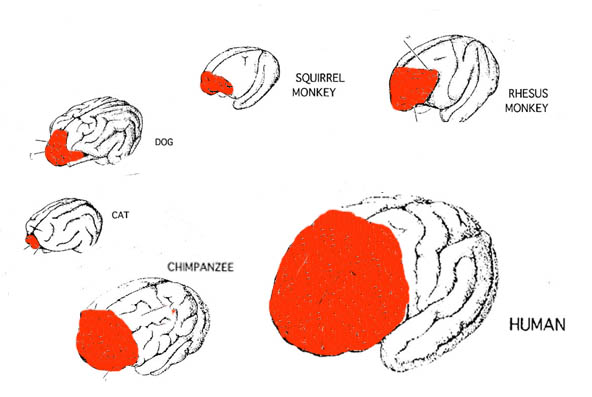
In his booklet, "What Science Can't Discover About the Human Mind" (here). Herbert Armstrong stated that the difference between human and animal intelligence could not be explained scientifically, and that this difference was due to the spirit in man. Armstrong also claimed that humans can reason, due to the spirit in man, but that animals can operate only on instinct.
Was Armstrong right? Or can science explain the difference in intelligence between man and animals without the spirit in man?
Herbert Armstrong's followers need to revise their views on animal intelligence after digesting the material below.
Let's start by looking at some statements made by Herbert Armstrong (HWA) in the booklets, and my (GL) response.
HWA: "There is virtually no difference in shape and construction between animal brain and human brain." (p. 3-4)
GL: That statement is ridiculous! There are big differences in shape, construction, size, structure, function, and quality, as we shall see.
HWA: "The brains of elephants, whales, and dolphins are larger than human brain ..." (p. 4)
GL: Elephants and whales are large animals, and since the brain plays a vital role in coordination and other body functions, those animals need large brains to coordinate their large bodies. We'll talk about dolphins later.
HWA: "... the chimp's brain is slightly smaller [than ours]." (p. 4)
GL: To say that a chimp's brain in only "slightly" smaller is rubbish. The chimp's brain is only 1/3 the size of a human brain! That's a big difference. Why would Armstrong call that only "slightly" smaller? Was Armstrong trying to prove that the difference between humans and chimps must be spiritual, since our brains are (supposedly) only slightly different? Did he intentionally minimize and ignore brain differences in order to promote his view?
Size does not tell us everything but it still makes a difference. How smart would you or I be if we only had 1/3 of our brains?
The human brain has much more cerebral cortex than the chimp's brain. That's the part of the brain that we use to think (in particular, we think with our prefrontal cortex). An animal without legs can't walk, and an animal without a prefrontal cortex simply can't think. (The exception would be an animal, if any, equipped with some special brain region that can perform a similar function).
Note how much more prefrontal cortex (the red areas in the figure below) there is in humans than in other mammals.

HWA: "Qualitatively the human brain may be very slightly superior ... " (p. 4)
GL: The statement is ridiculous! The human brain has more cerebral cortex than almost any animal brain. That makes our brains better at thinking. Qualitatively, the human brain is way superior to animal brain, in almost every case. Our prefrontal cortex is not only larger, but it has more folds and more layers.
That statement was known by science to be false even when HWA wrote the booklet. Was Armstrong being honest?
HWA: "... but not enough to remotely account for the difference in output.... What, then, can account for the vast difference? Science cannot adequately answer." (p. 4)
GL: Although research into human and animal intelligence and brain function is still going on, most of the difference between human and animal intelligence can already be accounted for by science.
HWA: "Some scientists, in the field of brain research, conclude that, of necessity, there has to be some nonphysical component in human brain that does not exist in animal brain. But most scientists will not admit the possibility of the existence of the nonphysical." (p. 4)
GL: What scientists say that? How long ago did they say that? In the 1700s? Did Armstrong or his followers ever quote any recent paper or book where scientists say that? I doubt it. Did he just make that up? The bible says "prove all things" so we should not accept that without proof.
HWA: "What other explanation is there? ... science has NO explanation ..." (p. 4)
GL: Well, if the reader will pay attention to the scientific material on this site, we'll see that science DOES have explanations for almost all the difference between human and animal brains.
The material that we present here shows that Herbert Armstrong's view of the science is way off from current brain research.
This subject is much more complex than Armstrong made it sound. I don't claim to be an expert, but I'll try to summarize some important points from science that Armstrong got wrong.
In particular, it seems he was wrong for at least the following reasons:
Let's discuss some of these points in more detail.
According to Armstrong, only the spirit in man can explain why man can out-think larger animals with larger brains. But let's see what science has discovered about that. The following quote is from the science site www.nature.com here.
One simple metric [way of measuring] for assessing relative "intelligence" is the encephalization [brain folds] quotient (EQ), which is (roughly) an animal's brain mass to body mass ratio. The logic behind this is simple: as an animal's overall size is larger, the amount of their brain's total area devoted to dealing with the increased body size also increases. Think about how much bigger an elephant is than us, and how much more skin they have to feel with, and how much more muscle mass their brains need to control. So given a certain body size, we know that a certain amount of brain is needed just for basic movement and sensation. If the brain is bigger than what we'd expect given their body size, that may be an indication of greater intelligence. By way of comparison, humans have an EQ around 7.5, other primates [man, apes, and monkeys] are around 2 to 3, and dogs and cats are around 1.0. Whales and dolphins are around 3 to 6, and their brains are highly complex ...
So we see that large animals like whales and elephants need large brains for their large bodies. Armstrong did not mention that. By neglecting that point, Armstrong's readers get the wrong idea. They are then led to believe that humans out-think those larger brains because of the spirit in man. However, there is a logical physical explanation for why humans can out-think larger animals with larger brains: more of our brains are devoted to thinking rather than to just managing our bodies.
Remember that Armstrong said: "There is virtually no difference in shape and construction between animal brain and human brain." (p. 3-4)
However, what does science say? My next quote is from Michigan State University here.
The cerebral cortex is the outer layer of advanced brains ... It is the seat of all higher mental functions. All mammals and most other animals have one to some degree, but in the primates and cetaceans [whales and dolphins] it is extremely well-developed. (Michigan State)
So, according to the scientific source, most animals do not have a very well developed cerebral cortex, and some have none. Only a very few animals, primates and cetaceans, have one that is well developed. Since the cerebral cortex is the part of the brain that we think with, it's no surprise that few animals can (possibly) rival man in intelligence. In other words, in the vast majority of cases, science CAN explain the difference between man and animal brains. It's simply the cerebral cortex.
Pictures of brains also show that some species (especially humans and dolphins) have a lot more folds than other species. This is just one of many ways that brains differ in quality, contrary to Armstrong's claims. Understanding of brain folds was well known when Armstrong wrote the booklet, so there is no excuse for the error. Such scientific "facts" presented in the booklet were clearly not researched; they were just made up.
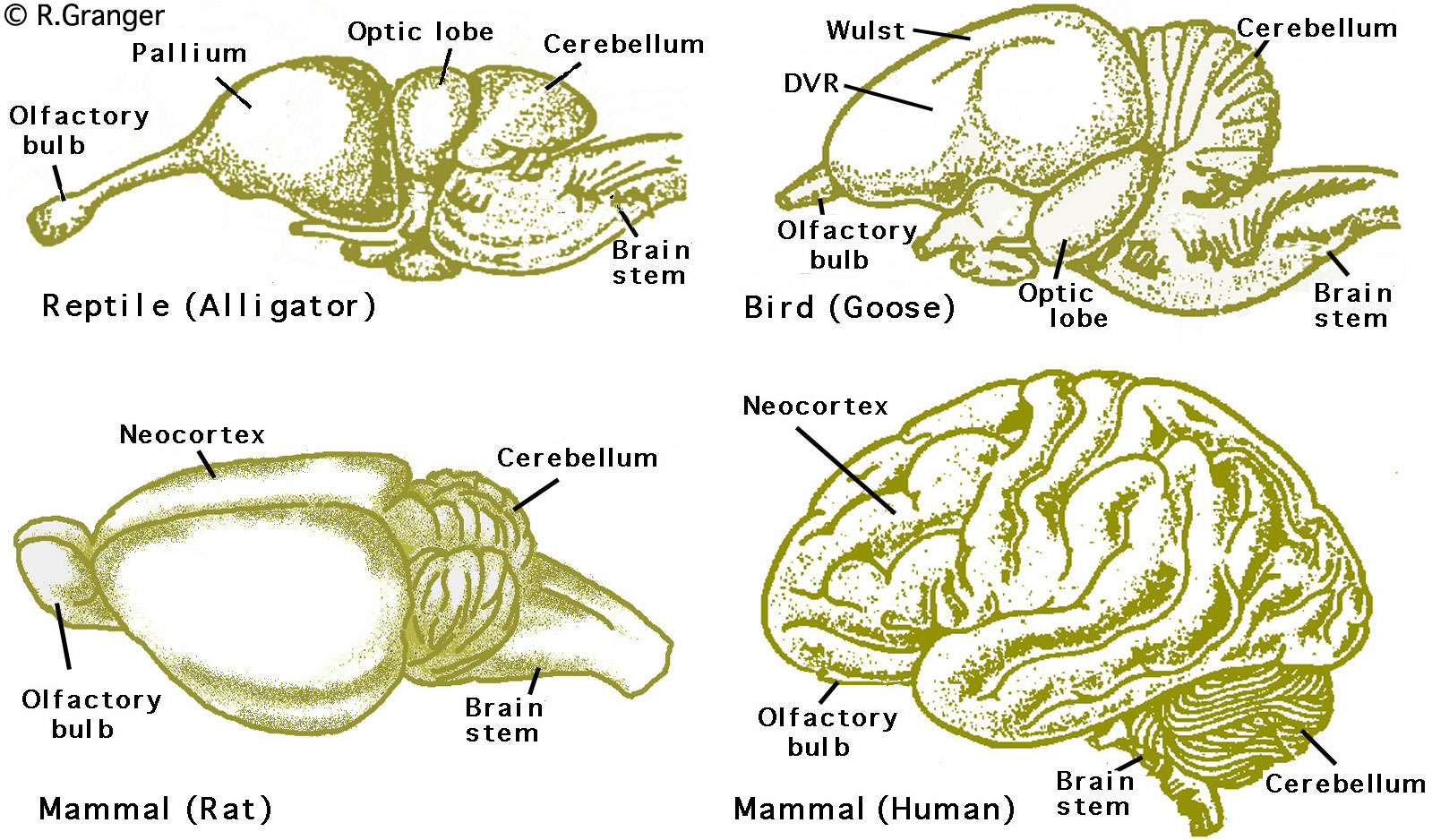
Comparing brains is a bit like comparing motorcycles. To someone who knows almost nothing about motorbikes, the following three bikes bear a superficial resemblance. And in fact, they have much in common. All three have two wheels, two tires, handle bars, a seat, an engine, a tailpipe, front and rear fenders, and so on. But tell a motorcycle expert that you don't see much if any difference and he'll think you're blind or stupid or that you don't know a thing about motorcycles!



One is designed for going over dirt trails (over rocks, logs, up steep hills, etc), one is designed for a relaxing cruise down the road, and the other is designed for racing at high speeds. They are all very different machines with very different capabilities. But to understand that requires an appreciation for motorcycle design, and that requires some time spent learning about motorcycles.
The same is true of brains. They might look similar, superficially, and contain similar components, but they have very different capabilities. Spend a few days learning about brains (like I did when I did the research for this article) and you'll begin to get an appreciation for their many differences.

By claiming that there is little brain difference between animals and man (which is completely false), Armstrong shows that he knows nothing about brains (you could say that he had no brains about brains). Then, by talking about the smartest of all animals (whales, dolphins and chimps), Armstrong seems to imply that whale, dolphin, and chimp brains are typical of animal brains. Nothing could be further from the truth. They are among the smartest of all the thousands of animals species. As such, they are special cases that we need to examine in more depth. But as far as the vast majority of animals goes, we already have the answer: science has shown that man vastly outperforms most animals simply because most animals don't have a well-developed cerebral cortex. Without that, they simply can't think! No spirit of man is needed to explain human superiority to them.
Only some animals (all of which are mammals) have any significant amount of folding of the cerebral cortex.
This image shows that animal brains also vary vastly in structure from the human brain and from those of other animals. In each case, the shape and size of the brain is very different. Also, the relative sizes and positions of the various parts changes greatly from one species to the next. Even superficially, the squirrel and frog brains are much smoother than the others, and the frog's brain is much flatter and narrower than the others. Etc.
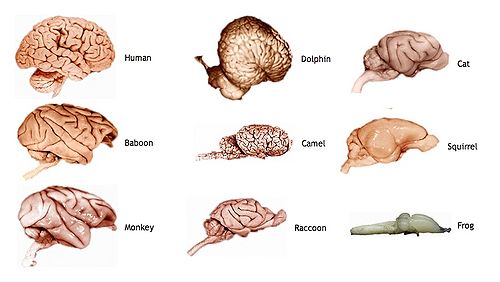
Here is another image reinforcing the same point. Though there are rough similarities in the brains, there are also huge differences.
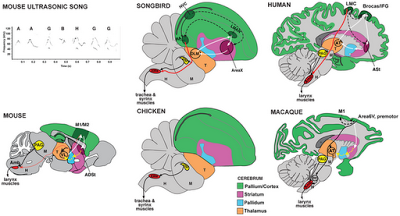
The scientific article continues:
In cetaceans [whales and dolphins], the cerebral cortex is very large, especially in relation to the rest of the brain. Since the cerebral cortex covers the more primitive areas of the brain in a thin layer, the amount of surface area available for it is important. The brain manages to obtain more cerebral cortex through encephalization [folding], or convolutions on the surface of the brain. The amount of encephalization [folding] is considered an important factor in intelligence, since it can greatly increase the amount of area for the cerebral cortex [the part of the brain that thinks] (Morgane 1974). (Michigan State)
Only in primates and cetaceans does the brain possess any significant amount of encephalization. (Michigan State)
Why didn't HWA mention the folds of the cerebral cortex? Why did he tell us that "There is virtually no difference in shape and construction between animal brain and human brain." (p. 3-4)?
But what about those FEW animals that do have a well-developed cerebral cortex? Science is still researching the subject, but even now, we can go a long way towards explaining the difference scientifically (physically). In many cases, the part of our brain that does our thinking is still a lot bigger than in other species that have a well-developed cerebral cortex. In other cases, those animals might be a lot smarter than we have thought!
Armstrong used the spirit in man to explain man's vastly greater output. But what if our output is not vastly greater? Could some animals be smarter, but in different ways, than we are?
Armstrong emphasised that animals had very limited intelligence. He basically explained their behaviour as mere instinct. He seems to have underestimated the intelligence of even the dumber animals. Many studies have been done that show animals are smarter than we used to think. For example, apes have been taught certain language skills, and a bird was filmed bending a straight wire into a hook in order to extract food from a container. There are a number of videos on the Web which show animals solving problems. So they seem to be doing some kind of "thinking" even with their small and simple brains.
Many animals readily classify objects by perceived differences in form or color. For example, bees or pigeons quickly learn to choose any red object and reject any green object if red leads to reward and green does not. Seemingly much more difficult is an animal's ability to categorize natural objects that vary a great deal in color and form even while belonging to the same group. In a classic study, Richard J. Herrnstein trained pigeons to respond to the presence or absence of human beings in photographs.[40] The birds readily learned to peck photos that contained partial or full views of humans and to avoid pecking photos with no human, despite great differences in the form, size, and color of both the humans displayed and in the non-human pictures. In follow-up studies, pigeons categorized other natural objects (e.g. trees) and after training they were able without reward to sort photos they had not seen before.[41][42] Similar work has been done with natural auditory categories, for example, bird songs [43] (Wikipedia)

Dolphins are easier to keep in captivity than whales so most of the research on cetaceans [dolphins and whales] has been done on dolphins. The research shows that dolphins might be a lot smarter than we think. Because they don't have hands, they cannot build things like we can, but they might be just as smart as us, or they might come close. If so, we don't need the spirit of man to explain the difference between ourselves and dolphins.
Dolphins might be smart enough to have their own language of sorts, which we are only beginning to understand.
It is obvious that cetaceans communicate, as to whether this communication can be considered a symbolic language remains to be determined. However, there is strong evidence in favor of it. The presence of Broca's and Wernicke's areas [parts of the brain responsible for language] are a major indicator of this possibility. Not even in the other higher primates are these areas as developed as they are in humans and all cetaceans. (Michigan State)
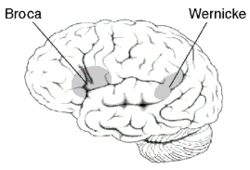
If dolphin brains come equipped for language, then dolphins probably have some kind of language.
We know that cetacean communication is very complex, but we have almost no knowledge whatsoever of just how any of it functions or what it means. Ironically enough, its complexity makes it the most interesting and possibly linguistic non-human communication but it also makes it the most difficult to study. (Michigan State)
Cetaceans evolved almost perfectly for complex communication and possible language. They have the distinct advantage over us in that their primary sense is the same as their primary means of communication, both are auditory. With primates, the primary sense is visual and the primary means of communication is auditory. (Michigan State)
Humans might not outperform dolphins mentally, given some astounding mental abilities that dolphins have:
Cetacean sound producing and analyzing [doesn't analyzing require brain power?] abilities are so adept that it is possible for a cetacean to project an auditory image identical to the sonar image they would receive (Bunnel 1974, Sagan 1975). So a dolphin wishing to convey the image of a fish to another dolphin can literally send the image of a fish to the other animal. The equivalent of this in humans would be the ability to create instantaneous holographic pictures to convey images to other people. (Michigan State)
If they do indeed do this (we only know that they can), then due to their large frontal lobes, there would be a natural tendency to abstract these images into words. In the development of a language there would not have to be a pairing of a sound with an object often enough for all your friends to understand what you are saying, you would merely have to project a stylized image to them. Due to a natural progression over the course of years, these images would become more stylized and abstracted that to call them anything other than words would be unjust. (Michigan State)
There are different ways of measuring intelligence, and different kinds of intelligence, so maybe dolphins are smarter than us in ways that we don't understand yet. For example, do dolphins have a high emotional IQ?
Flesh does not block sonar nearly as much as it does light. Cetaceans are able to use sonar to actually see the internal workings of other animals (Sutphen 1974). It is the same process as ultrasound that is used prevalently in medicine. Not only are they capable of this, but it has been proven that they do commonly use this to read emotion and states of health. This type of direct knowledge of another beings internal states would greatly benefit personal interaction and the possibility of a society. (Michigan State)
Here is just a partial list of the factors one must consider when comparing brains. Armstrong either ignored, glossed over, or made false statements about every item on the list.
In his booklet, he made it sound like his views were based on both science and the bible. But he got key scientific facts wrong. He was even wrong about some things that were known and easy to check out back when he wrote the booklet. Some crazy statements were as follows:
Armstrong misrepresented what was then known about brain science in order to lend weight to his interpretation of the bible regarding the spirit in man. Perhaps some things he just didn't know. Perhaps in his time scientists did not know just how smart dolphins were, but they certainly knew a lot more about human and animal brains than he was willing to admit that they knew. It seems clear that he intentionally misled his readers. He either lied about the research or he didn't do any and pretended that he did. Either way, it was dishonest.
In the footnotes below I have a fairly lengthy note on the history of brain research. It shows that Armstrong's statements about brains were known to be false decades before he wrote his booklet.
From a theological perspective, people can believe what they want about the spirit in man. But Armstrong was wrong to pretend to use science to support his theology. Until all the factors listed above (and more) are carefully and fully taken into consideration, it is not possible to fully compare human brains to animal brains. Nevertheless, what we do know about brain science so far already explains most of the differences between man and almost all other animals. The very few animals that have large complex brains, like dolphins, might be about as smart as we are, and in some ways smarter. There is no scientific basis for the claim that we have vastly superior natural abilities to all animals, or that differences in abilities can never be explained by science.
1. Videos of Smart Animals
A chimp outsmarts a human in a memory test! A crow solves a puzzle. Dolphins.
See videos (here) showing smart animals.
2. Dolphin Brain Structure. More on structural differences: "Dolphins have two hemispheres just like humans however, theirs are split into four lobes instead of three. The fourth lobe in the dolphin's brain actually hosts all of the senses, whereas in a human, the senses are split. Some believe that having all of the senses in one lobe allow the dolphin to make immediate and often complicated judgements that are well beyond the scope of a human ability." (from here).
So don't let anyone brush aside structural differences.
3. Folds. Notice the difference in the number of folds between the two brains below.

So don't let anyone tell you all brains are of the same quality.
4. Octopuses. Has science discovered that animals are smarter than we thought?
Octopuses are smarter than you probably think. See here.
5. More quotes from Armstrong's booklet
HWA: "I have explained that human brain is almost identical to animal brain ..." (p. 5-6)
GL: Yeah, but you just made that up, and it's very very easy to disprove.
HWA: "The brain thinks—although the spirit imparts the power to think, whereas brute animal brains without such spirit cannot, except in the most elementary manner." (p. 6).
GL: That's usually because they have little or no pre-frontal cortex.
HWA: "The brute animal has a brain virtually identical to the human brain—and some even larger." (p. 7).
GL: Animals have little or no pre-frontal cortex. And what they do have is almost always inferior to ours. Most animals with large brains need them to manage their large bodies.
HWA: "This human spirit also adds to man a spiritual and moral faculty not possessed by animals." (p. 10).
GL: Actually, there is some evidence of animals acting unselfishly, so we might not be as superior as we think.
On pages 12-13 of the booklet Armstrong shows a few different animal brains, which is supposed to show how similar they are in basic structure. This is supposed to show their brains are as good as ours. He simply never discusses the vast physical differences, as if they are not worth mentioning!
HWA: "God has bestowed MARRIAGE and FAMILY life on NO OTHER form of life except on HUMANS, whose potential it is to enter the FAMILY OF GOD!" (p. 15)
GL: Some animals are extremely social creatures. Some mate for life. Some live in close-knit family groups.
6. Mice. According to this, mice who received human brain cells became a lot smarter, which shows that our brain cells are better.
7. Prefrontal Cortex.
In the booklet Why Were You Born? (here), Armstrong said (p. 7-8):
By instinct, beavers build dams. But all these dams follow the same pattern. The beaver cannot think out some new, different pattern and make some new and different thing. Ants may form ant hills; gophers, snakes and rodents dig holes; birds build nests. But they always follow the same pattern. There is no originality, no thinking and designing of a new idea, no new construction. The beavers' dams, the ants' hills, the gophers', snakes' and rodents' holes, the birds' nests are all made purely by instinct, not by thought and original designing. A test was made with weaver birds. For five successive generations, weaver birds were kept in a place with no nest-building material available to them. The fifth generation had never seen a nest. But when nest-building materials, along with other materials, were made accessible, that fifth generation immediately made nests. And they were weaver-bird nests — not robins' nests or swallows' nests or eagles' nests. Evolution cannot account for the fact that animals are equipped with their marvellous instinct — yet with total absence of MIND power. Nor can it account for the absence of such instinct in MAN. Or, for the vast gulf between the powers of animal brain and human mind.
Well, most animals are dumb because they have no pre-frontal cortex or because their pre-frontal cortex is not very large or well-developed. That accounts for the vast gulf in brain power, whether one believes in evolution or not. But even then, many of them are smarter than he thought, as the material on this site shows. The difference between animal and human brain is not the great mystery he made it out to be.
Here we compare the pre-frontal cortex in man to that in other animals.
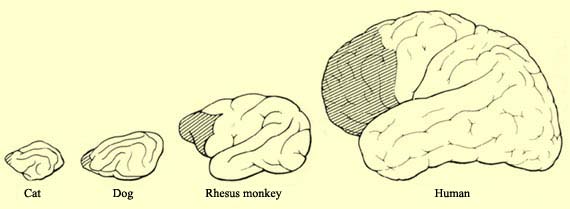
Skulls with low sloping foreheads cannot house a very large pre-frontal cortex.

It's not just the size of the prefrontal cortex that matters, but also other factors, such as how well it is connected to the rest of the brain. The role of the pre-frontal cortex is explained in this quote from McGill University:
The various species of vertebrates are very similar in the way that their brains are organized. For example, all vertebrates have a forebrain, midbrain and hindbrain, within which are found all the major neural systems that have evolved to perform functions common to all species.
However, the various species also have areas of the brain that have specialized in distinctive ways in response to the specific constraints of their environments. The human brain is about three times larger in volume than we would expect in a primate of comparable size, and the proportions of its parts to one another are different than in other primates. For instance, in humans, the olfactory lobe [responsible for our sense of smell] is only 30% of the size it would be if it were in the same proportion to the entire brain as in other primates. It follows logically that if the human brain overall is nevertheless much larger than would be expected in a primate our size, then some of its other structures must be proportionately far larger. And indeed, when we trace the brain’s evolution from fish to amphibians to reptiles to mammals and finally to humans, we see that the parts of the brain that have grown the most in human beings are in the neocortex, and more specifically the prefrontal cortex.
... For many years, scientists believed that humans' unequalled abilities for planning and abstract reasoning were attributable to their having a more developed prefrontal cortex than other primates.
To clarify, scientists still believe that the cortex, especially the prefrontal cortex, is the reason we are smarter than other animals. Here it is talking only about why we are smarter than other primates. The question is whether the prefrontal cortex alone can fully explain our superiority over large primates like gorillas which also have fairly large brains.
Continuing the quote from McGill:
But studies conducted in the first few years of the new millennium have called this idea into question [i.e. the prefrontal cortex is now considered only part of the reason we are smarter]. Earlier studies had compared the human brain to those of other primates, but had not included most of the great apes. In these more recent studies, magnetic resonance imaging has been used to measure the relative size of the prefrontal cortex in all species of great apes, including humans. When this new method was applied to this broader range of species, the relative size of the prefrontal cortex was found to be almost the same in humans as in the great apes who are our closest cousins (chimpanzees, bonobos, gorillas, and orangutans).
According to the authors of these recent studies, humans' superior abilities to anticipate and to plan [compared to other primates] can more correctly be attributed to other specialized regions of the cortex and to denser interconnections between the prefrontal cortex and the rest of the brain. The main reason that the prefrontal cortex is slightly larger relative to the rest of the brain in humans than in most other primates is that humans have a larger volume of white matter in their prefrontal cortex. This white matter is composed of myelin-covered axons that communicate with other parts of the brain, thus providing greater connectivity between the prefrontal cortex and the rest of the brain than in other species.
This connectivity is essential for the proper functioning of our working memory, in which the prefrontal cortex plays an active role. Working memory is involved in many of the cognitive abilities that are so highly developed in humans, such as the abilities to retain information while performing a task, to verify the relevance of this information to the task in progress, and to keep the objective of the task in mind at the same time. Patients who suffer severe injuries to their prefrontal lobes can experience difficulties in relating the past, present, and future and hence in planning their actions. This phenomenon, known as "frontal syndrome", confirms the primary role that this part of the cortex plays in anticipation and in choices of all sorts.
The recent expansion of the prefrontal cortex, together with the increased plasticity and associative capacities of the neocortex, thus seems to be the source of many of the most typically human cognitive abilities.
More information on the prefrontal cortex can be found at the McGill site here.
8. Brain Research History. (i.e. Armstrong Was Without Excuse).
Scientists were measuring brains, dissecting brains, and comparing human brains to animal brains long before Armstrong was even born. To demonstrate that a fair bit has been known about brains for a long time, certainly more than Armstrong wanted his readers to know, let's cover some history of brain research. We'll start by comparing what was known in the 1800's and early 1900's about chimp brains and human brains.
Recall that Armstrong said the chimp's brain was only slightly smaller than ours. That of course is patently false, and is the most obvious distortion in his booklet. Measuring brain size is very easy to do, so it's inconceivable that in 1978 when Armstrong published the booklet, science could be so far off in measurements of chimp brain size. Armstrong must have known better. Either that or he didn't bother to research it, and yet acted like he knew what he was talking about, and made a completely baseless assertion (i.e. he just made it up).
He also said "There is virtually no difference in shape and construction between animal brain and human brain." (p. 3-4). I will show that he just made that up too.
Even in the 1800's, quite a bit was known that could have been used to refute that statement. That statement is not even true of chimps, which are closer to humans than any other animal. Humans and chimps have very different skull shapes, and so of course they must have different brain shapes.
Paul Gervais was a scientist who lived and died in the 1800s (1816 to 1879). Even then, it was obvious that chimp brains were different than ours. In his Histoire Naturelle Des Mammifères, published in 1853, 39 years before Armstrong was born, he produced the following sketch comparing chimp and human brains (not drawn to scale).
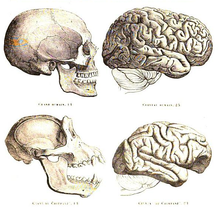
From the sketch by Gervais, it's obvious that the human brain has more and different folds. I.e. different structure.
In 1904, when Armstrong was 12 years old, Huxley produced the sketch below comparing chimp and human brains (also not drawn to scale). Superficially, these brains might look similar, but close examination shows many differences. They are only similar in a very general way because the diagram does not show many details. Again we see that the human brain has more folds.
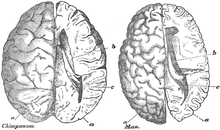
The main point I want to make from the above two images is that scientists were dissecting and comparing human and animal brains a long time before Armstrong wrote about those same brains. That's why I used the original sketches by Gervais and Huxley.
The two images above were taken from the Wikipedia article on Chimpanzees here on June 27, 2014.
Just five years later (1909), Korbinian Brodmann mapped out the human cortex, and produced the following maps of the human brain, in which he identified different parts of the cortex. His maps were based on how neurons were organized. Later it was confirmed that many of the different areas he identified had different purposes, as he suspected.
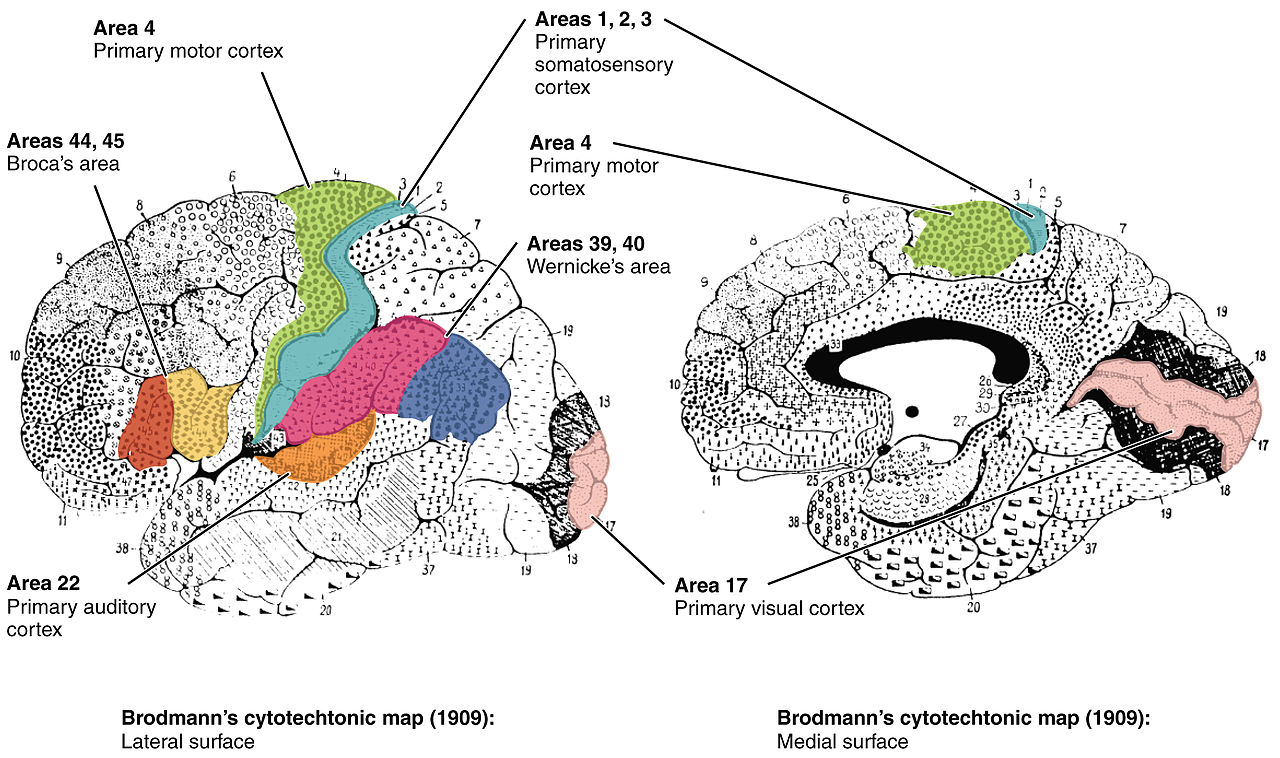
The Wikipedia article on Brodmann Area states that in 1909 Brodmann published his maps of areas of the cortex in humans, monkeys, and other species. In the same year, he also published information on cell types in the cortex and on its layered structure. Science was already on the way to understanding the basic structure of the brain. "Brodmann postulated that these areas with different structures performed different functions. Indeed, some of these areas were later associated to nervous functions ... " (Wikipedia article on Korbinian Brodmann, June 27, 2014).
In 1925, Constantin von Economo and Georg Koskinas produced their brain map, shown below.
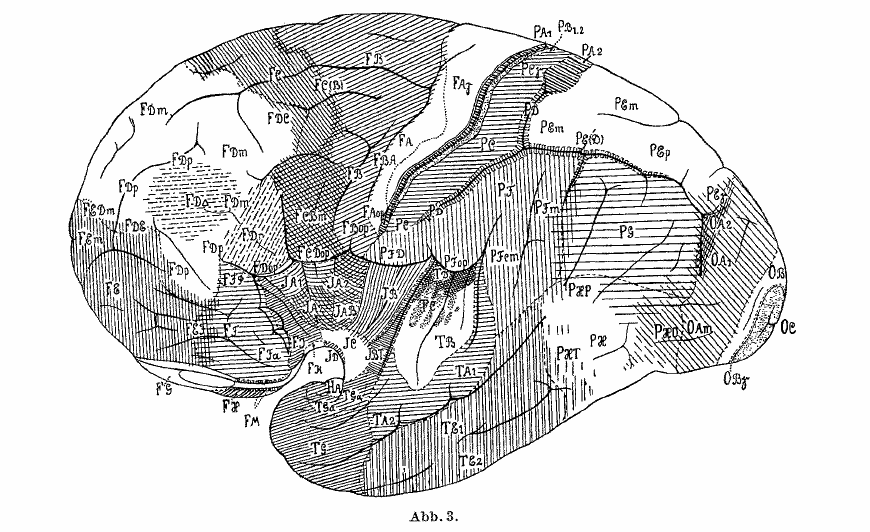
Their work was quite detailed. They produced an 800-page book, and a second book of 112 photographs of the cortex. Like Brodmann, they created the maps by looking at brain tissue under a microscope and observing the different arrangement, organization, and structure of brain cells in each region of the brain.
It was already known in the 1800's that certain regions of the brain were responsible for different functions. For example, Pierre Paul Broca (1824-1880) discovered the region of the brain responsible for speech production in humans.
The Spanish scientist, Santiago Ramon y Cajal (1852-1934), made intricate drawings of brain cells of humans and other species. Hundreds of his drawings are still used today in education. A few of his many detailed drawings (which I found here) are shown below.
Here is a drawing Cajal made of neural circuitry in the the Hippocampus of a rodent:
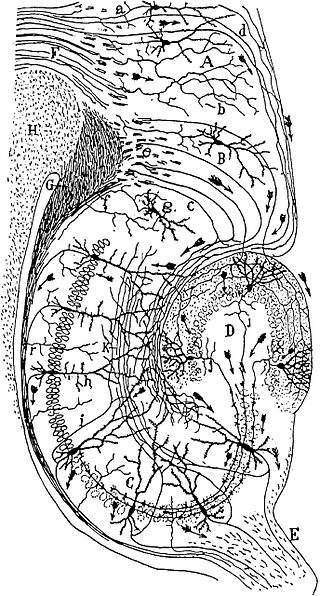
Below is a drawing Cajal made of cells in the brain of a sparrow:
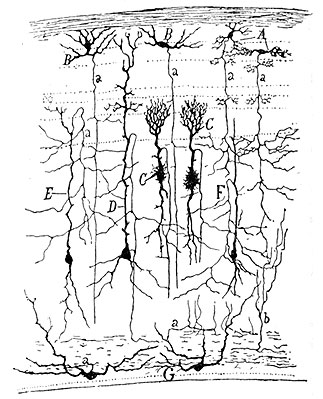
In particular, the sketch is of a sparrow's optic tectum (discussed in the Wikipedia article on Superior Colliculus), a component of the midbrain in vertebrates. The article says "The [optical] tectum is a layered structure, with a number of layers that vary by species." Cajal was making detailed drawings of subcomponents of the components of the brains in animals. So knowledge of all the main structures in those brains was probably already known. He would have known that each species has its own brain structure. And so, even then, science must have known that humans and animals had different brain structures, contrary to what Armstrong said.
Below is a drawing Cajal made of layers in the human cortex:
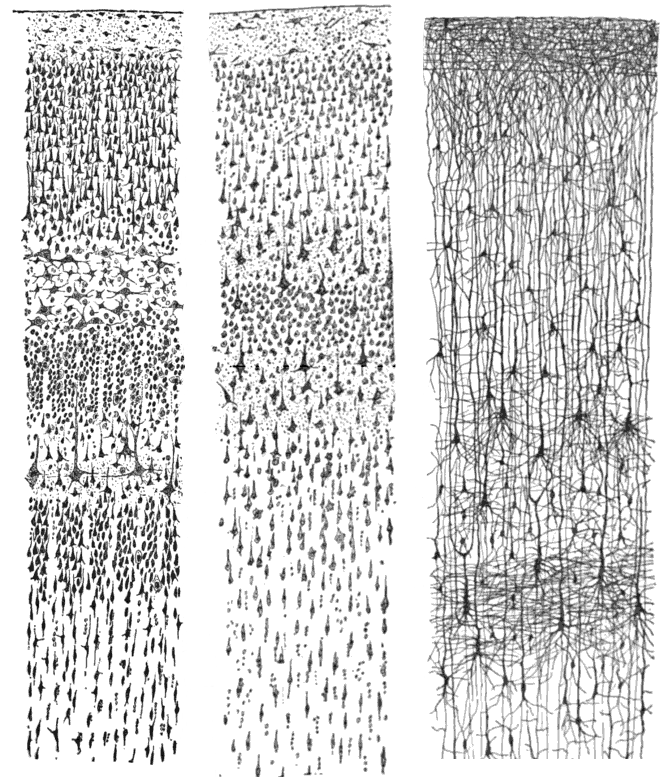
My purpose in showing these detailed images, is to show that detailed knowledge of human and animal brains, right down to the level of cells, was available decades before Armstrong wrote his booklet. If science had already mapped out the brains of human and animals, studied human and animal brain structures at the cellular level, identified different types of brain cells, etc, then science obviously knew that human and animal brains differed in structure.
So I have to conclude that Armstrong just made up the claim that science had found little or no difference in structure between animal and human brains.
9. Kanzi, a Very Smart Ape.
See videos (here) showing what this amazing ape can do. He can understand a few hundred words, follow a conversation, start a fire, play a video game, etc ...
10. How Smart are Whales?
Did a whale try to talk to his human trainers? Did this whale have social needs and long for companionship? (See here).
11. Copycat Pack
Does David Pack (leader of the Restored Church of God) do his own research or does he just copy his ideas from Herbert Armstrong without checking them out? David Pack wrote a booklet called What Science Will Never Discover About Your Mind (here) which is very similar to Armstrong's booklet. In it, he repeats the same unscientific nonsense that Armstrong wrote. Pack's booklet was written 30 years after Armstrong's booklet. During that time brain science and knowledge of animal intelligence have advanced, so Pack has even less excuse for ignoring the real science and using faulty arguments to promulgate his theological views.
Here is what Pack (DP) wrote in his booklet on the subject, along with my (GL) responses:
DP: For instance, certain creatures, such as chimpanzees and dolphins, have brains that are relatively similar in size [not true of chimps] and weight to that of humans. Some larger animals, like whales and elephants, have larger brains than man. Yet they are far less intelligent, far less creative and incapable of understanding any kind of complex thought. (p. 7)
GL: Pack uses the same FEW animals that Armstrong used as his examples, and he asserts, without any scientific proof, that all these animals are "far less intelligent" than man. Though that is probably true of chimps and elephants, it might not be true of whales and dolphins.
DP: Science has never been able to explain—to adequately account for—the vast difference [in output] between the human brain and the brains of animals. While man has a brain that may be only slightly more complex than animals of relatively similar brain size, the difference in capability is vast. There is simply no comparison. (p. 7)
GL: Just like Armstrong, he ignores all the evidence I presented, makes it sound like our brains are basically just like animal brains, acts like an authority on the subject, and asserts, without any proof, that science cannot explain it.
DP: ... animals function on instinct and possess paws, claws and hooves. This leaves them incapable of building something complex like a television—let alone a jet airplane or a space-traveling rocket—even if a mind were directing them. (p. 7-8)
GL: Animals not having hands makes it difficult to measure their innate mental potential. If dolphins had hands and could write maybe they could produce books, and over time, develop a body of knowledge comparable to ours. If they had hands to build with, they might be able to build many of the same things we can. We just don't know what they are really capable of. I don't know, David Pack does not know, and current science does not know. David Pack however, thinks (or acts like) he knows!
Furthermore, most humans are probably not smart enough to invent planes and rockets either. And those who do, can only do it after many years of study and reading books. A more fair comparison between human and animal abilities would be to compare an animal to an illiterate person in a stone age society. People who live in primitive societies without books have very limited material accomplishments.
DP: Animals are also not capable of acquiring knowledge beyond a very rudimentary ability to react to certain stimuli. ... Animals are greatly limited because God has merely programmed into them, through instinct, everything that they need to function effectively within their environment. (p. 8)
GL: Not true of all animals. Kanzi the bonobo has a pretty impressive vocabulary. And even dogs can learn tricks.
12. One of the "18 Restored Truths"
Herbert Armstrong claimed that he restored 18 vital truths to the church of God. According to several lists on the internet of these 18 truths, the doctrine of the spirit in man is one of them. The supposed ability of the spirit in man to empower the human brain to think is a part of that doctrine. The following quote is from a list of those "18 restored truths" from one of the websites (cog-ff.com) of the Church of God—Faithful Flock (which is led by Don Billingsley).
"Next [in the list of 18 truths is] the human spirit IN man. No other Church knows about that. That has been revealed to the Church. That is knowledge that has been restored to the Church of God. And this Church has that knowledge." The Bible teaches that "there is a spirit in man and the breath of the Almighty gives him understanding" (Job 32:8) which God did not give to the animals (e.g. Job 39:17). "For what man knows the things of a man except the spirit of man which is in him" (I Corinthians 2:11). Mr. Armstrong wrote, "This 'human' spirit imparts the power of intellect to the human physical brain" (Mystery of the Ages, page 105, hard cover edition). This spirit is not the same as the spirit of God which humans need to understand the things of God, but this spirit is needed to understand the things of humankind (Job 32:8; I Corinthians 2:11).
So if Armstrong was wrong about the spirit in man giving us the power to think, then this doctrine takes a hit. Theologically, there could still be a spirit in man. But scientifically, there is no evidence that we need it to be able to think. So maybe the COGs should now refer to the list of "18 restored truths" as "the seventeen and a half" doctrines.
13. An Error in the Bible?
The doctrine that the spirit in man gives us the power think seems to come directly from the bible: "For what man knows the things of a man except [by] the spirit of man which is in him?" (I Corinthians 2:11).
14. Human Brain Development
According to Pack, humans are born helpless, while animals are born with instinct (p. 7 of his booklet). That is supposed to help show that man has a mind capable of learning while animals only have a brain with extremely limited learning capacity (pp. 7-8). This, he believes, helps prove there is a spirit in man, because humans minds are so different than animal brains.
But we don't need the spirit in man to explain why humans are born helpless. According to brain science, the human brain takes a lot longer to develop than animal brains. As I understand it, that's because our large brains have to fit through the birth canal. For that to happen, they cannot be fully developed until after birth. But whatever the reason, the human brain continues to develop into adulthood, as shown in the chart below.
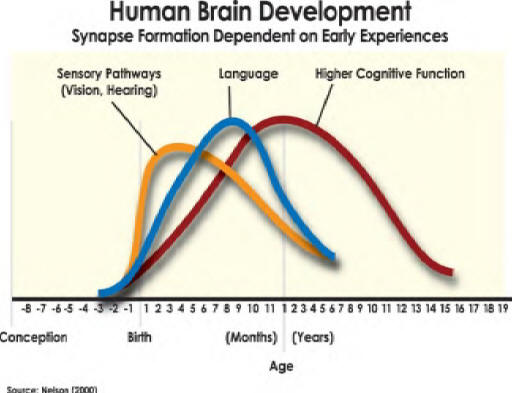
Since the brain of an infant is physically undeveloped, I don't see how comparing animal brains at birth to human brains at birth tells us anything about the spirit in man. It seems to me that it only makes sense to compare fully developed brains to fully developed brains. Using a faulty comparison confuses the issue. The human brain is still developing at an age long after many animals would have died of old age.
15. Birds. More information on bird intelligence can be found here.